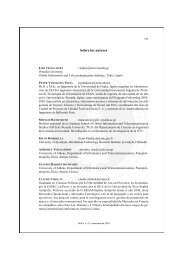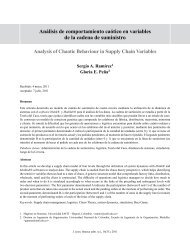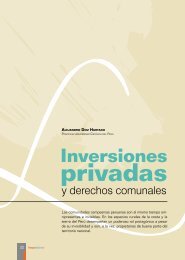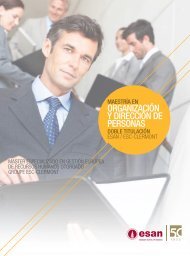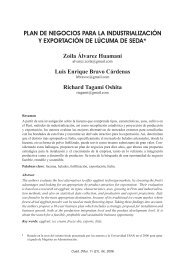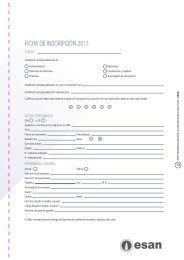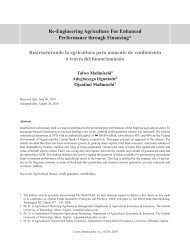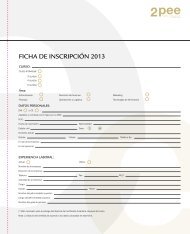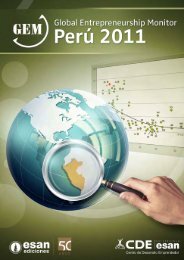Hofstede's Cultural Dimensions and Tourist Behaviors: A ... - Esan
Hofstede's Cultural Dimensions and Tourist Behaviors: A ... - Esan
Hofstede's Cultural Dimensions and Tourist Behaviors: A ... - Esan
You also want an ePaper? Increase the reach of your titles
YUMPU automatically turns print PDFs into web optimized ePapers that Google loves.
28 Journal of Economics, Finance <strong>and</strong> Administrative ScienceDecember 2011TOURIST BEHAVIOR DOMAINSAs discussed earlier in this paper, tourism is a complexglobal phenomenon involving a multitude of decisionsrelated to the purchase <strong>and</strong> consumption of a variety ofgoods as well as services. Marketing textbooks (Kotler& Keller, 2009) identify five stages of decision making:1) need recognition/purchase motives; 2) informationsearch <strong>and</strong> information acquisition; 3) evaluation ofalternatives, which involves rating of options <strong>and</strong> leadsto formation of preferences <strong>and</strong> formation of behavioralintentions; 4) actual purchase <strong>and</strong> consumption decision,which involves purchase transaction related decisions(dealer choice, br<strong>and</strong> choice etc.), as well as consumptionrelated decisions (frequency of purchase, lightversus heavy users etc.); <strong>and</strong> 5) post-purchase behaviorssuch as consumer satisfaction/dissatisfaction, br<strong>and</strong>loyalty/br<strong>and</strong> switching, complaining/complementingbehaviors, etc.The above five stages of consumer decision making<strong>and</strong> related consumer behaviors are regrouped intothree categories: 1) Before Purchase <strong>and</strong> Consumption;2) During Purchase <strong>and</strong> Consumption; <strong>and</strong>, 3) AfterPurchase <strong>and</strong> Consumption. The “Before” categoryincludes the first three stages of decision making listedabove, which lead to the formation of preferences <strong>and</strong>behavioral intentions. The “During” category includesstage 4 <strong>and</strong> deals with product purchase <strong>and</strong> consumptionrelated behaviors. The “After” category includesstage 5 <strong>and</strong> includes behaviors related to evaluationsof the purchase <strong>and</strong> consumption experiences by theconsumers. Parallel to this, the tourist behaviors areclassified into three overall domains: 1) Before-Travel;2) During-Travel; <strong>and</strong>, 3) After-Travel. Next, we identifyseveral specific tourist behavior domains under each ofthese three overall groups. These domains are labeledBT1 to BT14 (for the Before-Travel group), DT1 toDT11 (for the During-Travel group) <strong>and</strong> AT1 to AT30(for the After-Travel group). All these tourist behaviordomains are listed in Table 1.<strong>Tourist</strong> Behavior Domains Before-TravelThe first decision which a potential tourist is faced withis whether to travel or not, whether he/she can <strong>and</strong>/orshould travel or not. There are various reasons for thisdilemma. On the “No” side there may be personal,social, or financial constraints; there may be concernsrelated to the travel risk <strong>and</strong> safety, <strong>and</strong>, the individualmay have travel anxiety etc. On the “yes” side, thereis ample evidence documenting the benefits of travel<strong>and</strong> tourism. It fulfills a variety of personal, social, <strong>and</strong>recreational needs providing motives <strong>and</strong> incentives fortravel. These needs may be triggered by a particularoccasion, event or a life cycle stage. Overall, the prospectivetourist has to carefully weight the advantages<strong>and</strong> disadvantages of undertaking the travel <strong>and</strong> tourismactivity <strong>and</strong> take that very important first decision. Wecall this first decision “Yes-No to Travel” <strong>and</strong> label it asBT1. The Yes-No factors taken into account as discussedabove are labeled as follows: On the “yes” side, TravelBenefits <strong>and</strong> Travel Motivations (BT2), Travel Occasion/Event/LifeCycle (BT3). On the “No” side, TravelRisk <strong>and</strong> Safety concerns <strong>and</strong> Travel Anxiety (BT4),Personal/Social/Financial constraints (BT5).The assessment of the advantages <strong>and</strong> disadvantagesof travel <strong>and</strong> tourism requires information search<strong>and</strong> acquisition. The process of information search<strong>and</strong> acquisition continues in case the individual hasdecided to undertake travel. Now he/she needs tosearch <strong>and</strong> collect information related to a variety ofdecisions such as what destination, what type of travelarrangements etc. There exits a multitude of sourcesfrom which the information can be acquired such astravel agents, internet, relatives <strong>and</strong> friends etc. Theindividuals also vary in terms of their need for planning<strong>and</strong> prior arrangements. While the informationsearch <strong>and</strong> acquisition processes continue throughthe During-Travel stage, a substantial proportion ofinformation search <strong>and</strong> acquisition activity takes placeprior to travel. The above travel behaviors are labeledas follows: Information Search <strong>and</strong> Acquisition (BT6),Sources of Information (BT7), Trip Planning/PriorArrangements (BT8).Next, the individuals aggregate the collectedinformation <strong>and</strong> evaluate their alternatives to formpreferences. The evaluation process takes into accountfour main variables: 1) attributes used for evaluationJ. econ. finance adm. sci., 16(31), 2011



